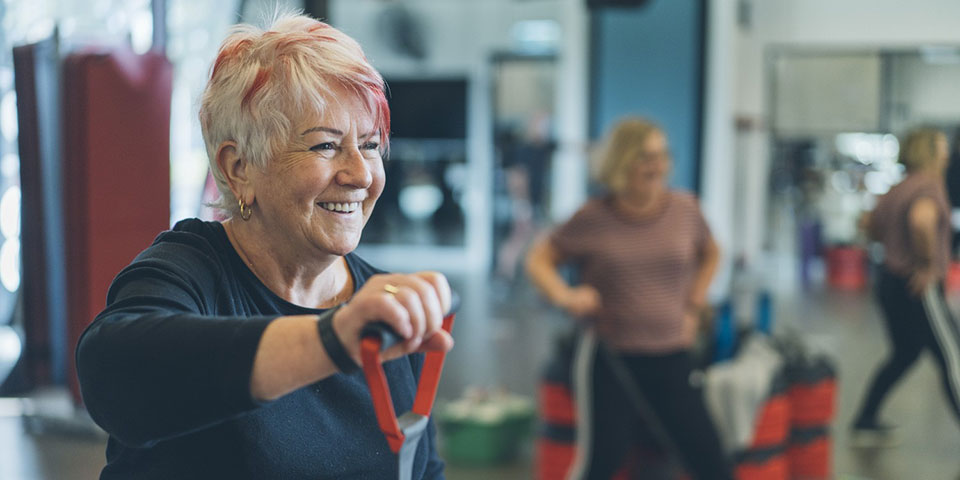‘98% of group fitness respondents said that the YMCA contributed to their life satisfaction and 89% reported a sense of belonging’
The mission of YMCA Victoria involves a commitment to making a meaningful difference in the community. The way to assess achievement of this aim involves monitoring the social value and impact of their facilities on its members, which is undertaken via consistent and extensive surveying of members across 20 of their sites across the state.
“We've done a lot of work on this and, especially in recent years, we’ve really gotten good at it; to the point where we’ve actually now got a dedicated team who conduct ongoing research around the social value and social impact of our facilities on our members,” explains Nadine Kemp, General Manager – Recreation at YMCA Victoria.
“We thought it would be good to look across the sites that have strong group fitness programs and see how it relates to the members and their feelings of connectedness and belonging to community,” says Nadine.
“When we look at measuring the physical and mental health of members, we've got some sites that do really well; often the data from these clubs also reveals strong feelings around Connection and Belonging to the facility, and to the people around them. And these sites with higher Connection and Belonging scores are typically occurring in centres that have very strong group fitness programs in place.”
How we collect data
“Our Social Impact Measurement (SIM) Framework enables us to assess and enhance our contributions through key outcomes: Physical Wellbeing, Mental Wellbeing, Connection and Belonging,” explains Nadine. “Our approach to data collection is as dynamic and inclusive as the communities we serve, and we achieve it in the following ways:
- Annual surveys gather rich, quantitative and qualitative data across all service lines, including Aquatics and Recreation.
- Focus groups and interviews capture personal stories and insights that illuminate the impact of our programs.
- Ongoing feedback through digital platforms, suggestion boxes, and regular check-ins ensures we're always listening”.
“When it comes to data analysis, we prioritise understanding the unique needs of each community group and we undertake this in ways such as:
- Demographic analysis segments data by age, gender, sexuality, cultural background, all-abilities and more, allowing us to tailor our programs effectively.
- Impact metrics provide benchmarks for comparison against state-wide and national datasets, underscoring our accountability and commitment to meaningful results.
- Quality assurance sees us working with university partners for academic rigour, including Monash University (Health and social care unit) and the University of Melbourne (Social Equity unit), and impact experts, Clear Horizon, for data verification and report writing”.
Nadine adds, “Transparency and engagement are key to our impact storytelling, so in terms of reporting and communication we use:
- Interactive reports to identify early insights, and deep-dive reports that assess performance against outcomes across different activities, demographic cohorts, local government areas and centres.
- PowerBI dashboards to deliver accessible, real-time data analysis, empowering staff and partners to explore and utilise insights.
- Centre-based communications and social impact cards share inspiring impact stories with our communities, celebrating successes and fostering connection.
- Insights and innovation help us continually reflect on our impact; we continuously learn and innovate.
- Strategic decision-making using data-driven insights to inform every aspect of our operations, from program design to partnerships.”
“We also do ‘pulse checks’ to immediately measure the social impact of a specific program. For example, for our six-week QFit health and fitness program (short for ‘Queer Fit’, provided for the LGBTQ+ community), we surveyed participants to measure how they safe and connected to community they felt both before and after the program. This enables us to see the direct impact that the program has had in making this community feel safe within our facility.”
By understanding and demonstrating their social impact, YMCA Victoria is able to support continuous improvement and offer tailored programming that meets the diverse needs of their communities. “With a focus on nurturing potential and championing change, we make a lasting difference in the lives of young people and the broader community,” says Nadine.
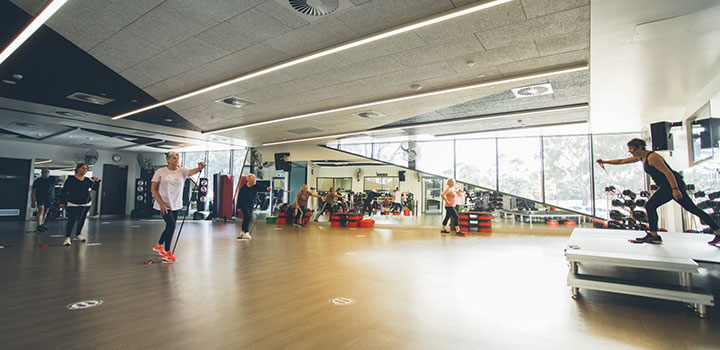
The findings
Having received this data, which confirms that members feel more connected with others through coming to the Y; that they feel part of the community, a sense of belonging, the comfort to be themselves, and that they’re accepted and welcomed by the staff at the Y, Nadine and her team then looked at the retention score, Net Promoter Score and the percentage of members who attend group fitness.
“We can measure the physical wellbeing of our members across all sites, and we can break the data down site by site. Recent data shows that 86% of our members were meeting the physical activity guidelines, and that 85% of them said that they were doing some or all of their physical activity at the Y,” says Nadine. “For group fitness participants, it was even higher with 92% meeting the physical activity guidelines and 92% doing some or all of their physical activity at the Y."
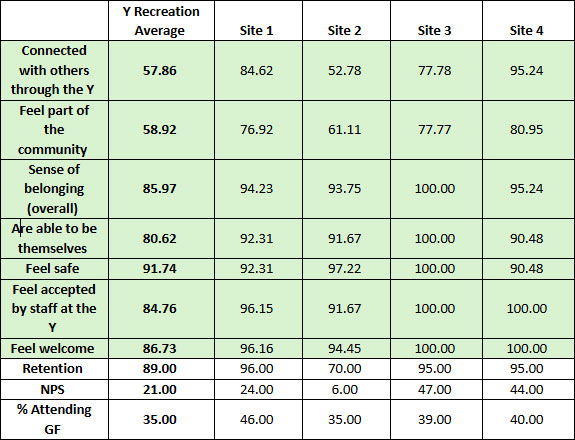
“In terms of our members’ mental wellbeing, we had an average life satisfaction score of 7.61 out of 10, which is a really great score – and measured by those who selected ‘a lot’ or ‘a little bit’. And when we look across Victoria, it's a little bit lower at 7.46. 94%of these members felt that the Y contributed a to that life satisfaction. For group fitness participants, life satisfaction scores were even higher at 7.76, with 98% of respondents saying that the Y contributed to their life satisfaction”.
“They also reported feeling connected with others through the Y, so the average Connection and Belonging scores were good too; of course, we've got some sites that sit a lot higher and some that are lower, but the average Belonging score indicated that 86% of members felt a sense of belonging through the Y. For group fitness participants, this was even higher at 89%. This suggests they're able to be themselves, feel safe, feel accepted, and feel welcomed; and this positive social impact is exactly what we’re all about at the Y.”
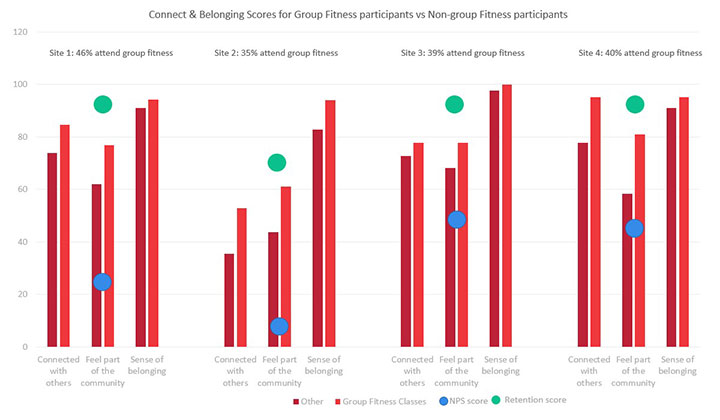
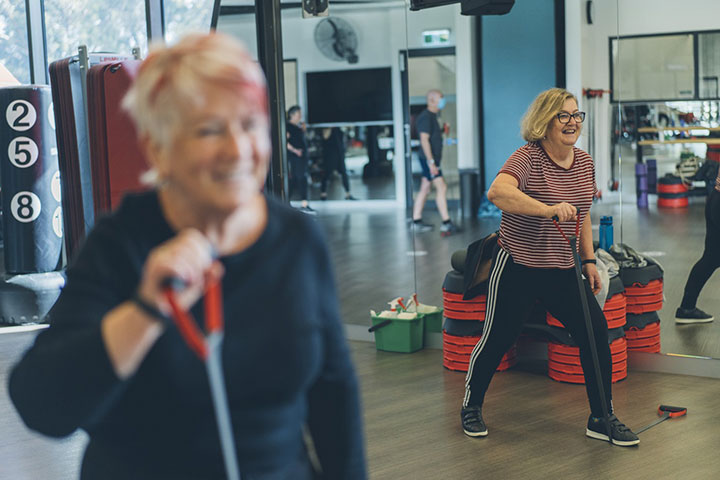
When you analyse the data, you can see that although some sites fall above and some fall below the average scores, the physical and mental health of members, along with their feeling of connection and belonging does appear to have a correlation with participation in group fitness.
Of course, it’s not ALL about the numbers
“It’s important to remember that when it comes to community and the success of your programs, it’s not always about participation numbers,” Nadine says. “For example, you might only get 12 people show up to a program but if 100% of those participants made a friend or created a connection or solidified a friendship, then that program is a huge success. It isn’t always only about how many people show up.”
Got a positive case study of GX success that you’d like to share? Drop us a line at marketing@lesmills.com.au.
